|
January 1947 Radio-Craft
 [Table of Contents] [Table of Contents]
Wax nostalgic about and learn from the history of early electronics.
See articles from Radio-Craft,
published 1929 - 1953. All copyrights are hereby acknowledged.
|
Radio-Craft magazine
dedicated its January 1947 issue to the fortieth anniversary of Lee de Forest's
invention of the Audion tube - the world's first successful controllable
electrical signal amplifying device. Many articles are presented that were
written by people who knew de Forest personally (including editor Hugo
Gernsback) and followed his progress and/or actually worked with de Forest
during his experiments. This particular "Birth of the Audio" piece was by
Frank E. Butler, who provides "A first-hand account written by an assistant of de Forest throughout the hard
years which immediately preceded the most revolutionary invention in all the history
of radio." If you have never read an account of the evolution of the
Audion, you need to read this. It is akin to the path Thomas Edison took when
working to perfect his incandescent light bulb. When you have no prior work to
draw upon, success often requires tiresome repetition using slight variations
with each trial, and, significantly, having the ability to interpret results and
recognize what is and is not contributing to the success. See the
Table of Contents
for other articles about de Forest's efforts.
Birth of the Audion
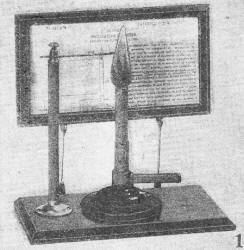
Audion #1 - Bunsen burner was lighted and adjusted to an intense
blue flame.
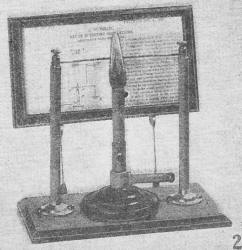
Audion #2 - Two flames must be better than one.
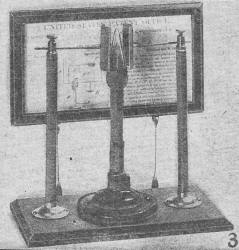
Audion #3 - "Blinkers" or reflectors to concentrate ions.
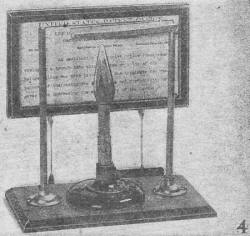
Audion #4 - Trough for burning elements.
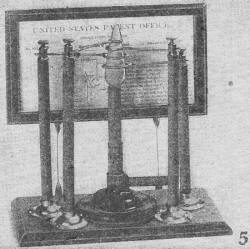
Audion #5 - Four terminals including a control grid.
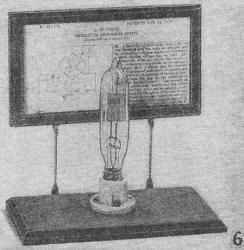
Audion #6 - Electric heater rather than a flame, with a vacuum.
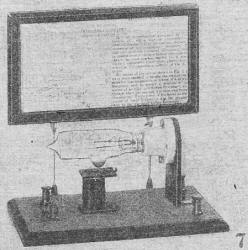
Audion #7 - Pool of mercury in the glass.
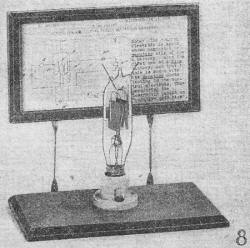
Audion #8 - First use of a "B" (bias) battery on the plate.
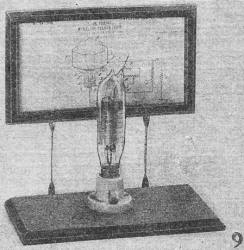
Audion #9 - First amplifying tube using spiral tin foil on outside
of glass as control grid.
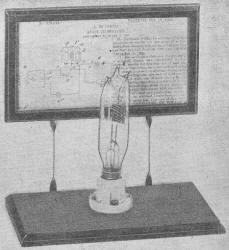
Audion #10 - End of de Forest's long search for the better detector
- the original grid audion.
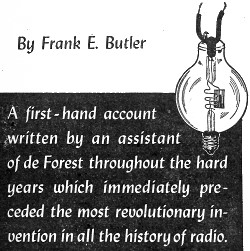 By Frank E. Butler By Frank E. Butler
A first-hand account written by an assistant of de Forest throughout the hard
years which immediately preceded the most revolutionary invention in all the history
of radio.
When I first became associated with Dr. Lee de Forest in 1904, the dependable
communication range of wireless was less than 100 miles.
At that time he was driven by two ambitions - to increase the sending distance
and to discover a better detector - with the greater stress on the latter. He reasoned
that improved detector sensitivity would automatically increase the transmission
range. None of the then current coherers, magnetic and electrolytic detectors did
ever satisfy the rigid requirements and hopes of de Forest. At this time a disaster
(which upon closer analysis was not a disaster but a real blessing in disguise)
occurred to de Forest. A court decision, in favor of Marconi, strictly enjoined
him "to forever desist from the manufacture, sale or operation of any system of
wireless telegraph."
Penniless, but not discouraged nor beaten, he rented a small, inexpensive space
in the Parker Building, then located at the corner of Fourth Avenue and 19th Street,
New York City. Here he started his renewed search for a "better wireless detector."
Watches, clothing, and keepsakes were pawned. His brother Charles made razor strops
with a special "lick-dob" on them for sharpening the blade, which I demonstrated
and sold in Hageman's drug store window across from the old Grand Central Station
as new experiments began and our hopes rose.
Ultimately the audion was invented as a result of brilliant reasoning by de Forest.
Up to this time all known methods of reception depended upon or were derived from
the three natural elements of water, earth, and air, notably metal filings, electrolytic
fluids, and iron magnets. The possibility of using fire - the fourth and only remaining
natural element - was at first unnoted, but the fluttering of a Welsbach gas flame
in the presence of a spark gap was the miraculous and meager clue flashed by Fate
to the keen mind which saw in it the path to his great discovery. His clue was the
possibility that heated gas molecules might be sensitive to high-frequency electric
waves. Such a theory was at least a new creative thought - not a copy or a follow-up
of anyone else's idea. But, how to use it and with what? That was the real problem
to solve. "Can heat hear?" was the first crude question! How was heat or gas or
both to be fondled, handled, and nursed into a practical application?
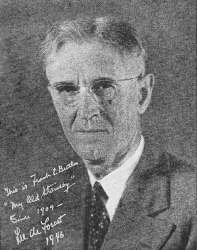
Frank E. Butler was born in Monroeville, Ohio, only a few miles
from the birthplace of Thomas A. Edison. Like Edison, he started his career as telegraph
operator from the same location and at the same age of 15 years. On June 10th, 1904,
he resigned as train dispatcher on the New York Central to become associated with
Dr. Lee de Forest in the young art of wireless telegraphy, and for many years afterwards
acted as his chief assistant. In 1908 he organized The American Wireless Institute,
the first school in the world to teach wireless engineering. Many present-day radio
executives and engineers are among his graduates, and he points out that from the
ruins of this pioneer school was started, in 1911, the forerunner of the RCA Institute.
Mr. Butler designed numerous early radio circuits; was sales manager of several
tube companies, among them Archatron, Volutron, Arcturus and Ken-Rad . He is known
among acoustical engineers as an inventor in this and the moving picture field.
Is a current writer for several technical publications and the author of books dealing
with the progress of wireless, radio and electronics.
As a result of de Forest's earlier preliminary tests, the fact was firmly established
in his mind that the proper and only successful detector should operate upon the
principle of relay action. According to this revolutionary idea some kind of automatic
trigger device should control the local energy from a booster battery (from which
the name "B-battery" is derived.) Activated by the incoming signals it would thus
re-create the audible sound of the original transmitted signal. The plan was simple.
Assuming that a circuit were used in which the antenna impulses passed through
a "gap of flame" to earth in the path of which there was inserted a telephone receiver
- and provided there was even a breath of signal coming in over that route - why
would it not be possible to boost or rejuvenate this feeble electrical impulse,
to amplify it into audibility by the use of an electrical booster of dry cells -
B-battery in embryo. With the inception of that idea the famous and very essential
B-Battery came into being, marking the first revolutionary advance in wireless since
its beginning - a step as important to radio and electronics as was Franklin's discovery
of electricity during an electrical storm by means of kite and key.
Dr. de Forest believed that if two bodies adapted for use as electrodes in a
wireless receiving circuit be slightly separated, the space between them could be
neutralized sufficiently to enable them to act as a detector of electrical oscillations.
Provided that the intervening gap be put into a condition of molecular activity
by the action of heat such a condition of ionic activity would cause what otherwise
would be a non-sensitive device to become sensitive to electrical wave influences.
His first impression was that this could be accomplished in free air, and so it
first was done. There was no intention at the start to enclose the heating medium
in a container of any kind, much less the thought of a vacuum.
Imbued with this revolutionary theory of using heat it was logical for de Forest
to think of an open flame that would be small, concentrated, and adjustable. He
selected for his experiments an open flame as generated in the common Bunsen gas
burner universally used in research work.
Several standards of various types and designs. for holding or suspending the
necessary electrodes were made, equipped with binding posts on top to admit the
ends of the wires. They were made so as to raise or lower the height of the extended
terminals which later were placed in or adjacent to the open flame. A low-power
transmitter was located on the other side of the room.
In this case, the distance between the sending and the receiving points was of
no consequence - the ability to receive something in the nature of a signal meant
everything.
De Forest's basic problem reduced to its simplest form was threefold: What kind
of heat to use? What kind of electrodes to employ? By what process could neutralization
of gap be best obtained? He did not realize that the answer to these three questions
would spell - radio tube! His original idea of a flame augmented by the B-battery,
and his ultimate development of the three-element tube with its filament, plate,
and grid, are identical in theory and operation - differing only in degree - an
undying tribute to the brilliant genius of Lee de Forest.
In his initial Bunsen burner tests a live flame stood between and divided two
electrodes with no physical means of contact (such as it wire or other metallic
medium). The heat of the gas created the "phantom medium" over which the signal
might flow. De Forest chose to call this phenomenon, ionic action, though he might
as well have called it electronic action.
The illustrations show explicitly and clearly the line of reasoning de Forest
followed from one test to the next, even though they do not include all the many
experiments that were tried, only to be discarded later as being impractical or
not applicable. Those shown here constitute only the major steps. They do not represent,
in the slightest, the complete research and intense analysis of de Forest as he
progressed methodically and confidently with his experiments. So thorough and extensive
were his tests that he applied for patents - not one but twelve! The first five
covered his experiments with an open gas flame.
Had de Forest been interested in copying any previous experiments of others,
as is so often unjustly and untruthfully claimed by those who were not there, he
naturally would have started his research with the bulb first, but it is significant
that the sequence of his patent applications shows how unerringly he pursued the
path of investigating heat as the only avenue to lead him to his goal - a path which
scientifically could not have been traveled to success in any other way. This is
a highly important historical fact.
In the first experiment (Fig. 1) a common Bunsen burner was lighted and adjusted
to an intense blue flame. The metal frame itself formed one of the two terminals
or electrodes, thus being a part of the electrical circuit. The standard holding
the second electrode was moved so that its projecting wire entered the area of the
flame near the center. Obviously the electrode which was placed in the flame was
of relatively higher temperature than the standard itself which formed the other
electrode. Thus was formed a local receiving circuit possessing a certain asymmetric
electrical conductivity which permitted the current from a few No.6 dry cells to
pass from the relatively cool burner stand to the more highly heated one. (Current
in 1906 always traveled from positive to negative.) Fortunately the adjustment of
the terminal wire in the flame during the first trial was perfect - quite by accident
- otherwise no signal could have been heard. But there was no mistake about this!
The signals were very weak, yes - but nevertheless they were real reproduced signals
sent across the room.
This initial test brought out two important results:
First it proved that heat was effective in detecting wireless waves. Second it
witnessed the birth of the B-battery - the importance of which cannot be emphasized
too much, because without this simple adjunct our present-day radio and electronics
would not be possible.
The second test (Fig. 2) was prompted by a query which in itself seemed trivial,
yet it was fraught with great possibilities, as later test proved.
"If one electrode in a flame produced such promising results - what will happen
if two terminals be immersed in the flame, and are different spots in the flame
more sensitive than others?"
Then another test (Fig. 3) suggested itself. Instead of using two plain points
of wires as terminals, why not employ "blinkers" or reflectors at the end of terminals,
and deflect or concentrate the "ions" across the flame. Another test consisted of
two wings - first plain flat pieces of metal, then perforated ones.
It was observed that the extreme outer edge or envelope of a flame appeared to
be the most sensitive spot and there was a difference in signal strength between
a cool wire just approaching or touching the flame and when, a moment later, that
terminal tip became red hot. It was also noted that varying the voltage of the B-battery
produced a marked difference in results. Every disclosure was startling in effect
and heightened the curiosity and anxiety of de Forest to probe even deeper into
this fascinating research. The next test (Fig. 4) was a radical departure from the
previous ones and illustrates the wide range of the inventor's imagination. This
consisted of a trough-like electrode suspended horizontally above the flame. Various
crystals of potassium, halogen sodium salts, etc., were placed in the trough, and
when heated would emit different gasses or rarefied heated air. Parallel to this
trough and above it was suspended a straight wire of the same length, this being
the second electrode. The idea of using salts was to improve the sensitivity of
the gap by further increasing its molecular activity. This was perhaps de Forest's
inception of a "rarefied area" such as only an evacuated medium could produce -
a radio tube in embryo.
Then followed the introduction (Fig. 5) of four terminals in flame arrangements.
This time the ends of the electrodes were made with rings of slightly different
circumference so that each terminal could snugly encircle the flame, one ring on
top of the other and each leading to a different part of the circuit. This test
again shows de Forest's original idea of keeping the high-frequency current path
distinct and free from that of the local telephone current - the idea of separating
the high-frequency from the audio circuits. It was in this experiment that de Forest
obtained his first vague idea that the influence of high-frequency impulses could
be impressed to better advantage on the conducting medium by means of a third electrode
(the "grid").
It now seemed that de Forest was running into a log-jam among so many results
- each of which presented its own set of baffling problems. The situation was bewildering
- the search too intense. Anything might or could happen to precipitate a crack-up.
It was this latter specter that haunted de Forest, for although he had learned a
great deal about the action of heat and its relative importance to wireless detection,
yet once again it was a whiff of air that turned the tide against him just as it
was a whiff of air that feebly fluttered the Welsbach burner that originally inspired
him. He had observed that the slightest draft of air could blow the flame out of
its delicate adjustment - thereby altering the action and rendering the reception
unstable. This observation sent de Forest into despondency as it convinced him that
no matter how successful his flame tests might be - or whatever type electrodes
he might use - its practical use, as for instance on shipboard, was impossible.
At last - the realization that the dead end of a street had been reached.
The instability of an open flame and its susceptibility to drafts then caused
him to shift to another type of heat-producing medium in an attempt to find the
necessary steadiness. There seemed nothing quite so handy, practical or promising
as a lighted incandescent electric lamp.
The first thing to be decided was the voltage and the number and kinds of electrodes
to use. It was de Forest's intention to follow the series of bulb tests along the
same sequence as was done with the flame. It would take longer, but at least give
the benefit of comparisons. A Christmas tree lamp with its small candelabra base
and low voltage was considered the most advantageous type. This style of lamp was
obtainable locally from a manufacturer named McCandless Incandescent Lamp Co. However,
making up only two or three samples of electric lamps which possibly would burn
out after only a few moments' trial presented a real financial problem. It required
unusual skill on the part of McCandless to construct the various electrodes and
then to evacuate the tube with a hand pump before sealing. Sample after sample was
discarded and yards of glass tubing sacrificed before the first crude specimen (Fig.
6) was produced. Then followed bulb after bulb, made along the same lines as the
previous flame-tests. Each produced varying degrees of good or bad results-representing
a maze of baffling problems. Then followed a test with a tube in a horizontal position
(Fig. 7) designed with a small cup on the bottom which held a portion of mercury.
The next test, using two wings (Fig. 8) is especially significant. It is not
only the original amplifier, but it also introduced for the first time the use of
a "bias C-battery" clearly shown in the patent drawing with its negative plate leading
to the control electrode - un assailable direct evidence that the idea of "negative
grid bias" positively was originated by de Forest (though it later meant a fortune
- to those concerns controlling the Lowenstein patents).
With this idea fresh in mind de Forest next tried a tube having only one wing
and filament. He pasted a strip of tin foil on the outside of the tube (Fig. 9)
which he used as one electrode - but this produced no favorable result. A safety
razor blade was lying within reach. Preoccupied with many thoughts de Forest carefully
cut the tinfoil - round and round - into a long spiral piece like a spring, without
changing its location where it was pasted. This simple act had the effect of making
a coil of flat metal instead of a flat plate - two quite different and distinct
things electrically. This was hooked up and tried. The result was startling. Hopes
rose. This also was the time a 6-volt storage battery with adjustable resistance
was used for filament supply. Likewise the amount of B-voltage was set at 22-1/2
volts with a potentiometer for varying its potential - two items that remained standard
in future radio circuits for many years afterward.
Experiments were continued with a wire instead of a tin-foil spiral. De Forest
figured he had too much wire wound around the tube, which luckily was a sturdy one,
able to withstand the series of additional tests. Signal strength continued to increase
as he kept constantly snipping small pieces of the coil to reduce its length.
Finally when only about 1-1/4 inch remained of the original coil - not even enough
to completely encircle the glass - he obtained his greatest results, and he stopped
there. Feverishly he took this small length of wire and with a pair of long-nosed
pliers bent it into a flat zig-zag shape having the over-all dimensions of the flat
1/8-inch wing. This was taken over to McCandless. Dramatic and intense moments followed.
"It is my impression," said de Forest, "that if we take this zig-zag wire and
place it on the inside where it will be closer to the hot filament and the cold
wing we'll notice a decided improvement. In fact I believe the closer we group the
three elements the more effectively they will operate."
At this point de Forest sketched the idea he had in mind. Here again was shown
the third or C-battery in the input circuit. This indispensable C-battery, like
its big brother B-battery were both discovered and used before their famous sister
the grid came into existence!
Several sets of tubes were made with the elements in different locations. Each
was carefully tried. One of these was made with the zig-zag wire interposed, between
the filament and the wing. By a streak of fortune this was the last one to be tested.
Disconnecting the previous tube, de Forest reached for the remaining specimen
that was still resting in the old shoe box filled with cotton batting in which it
was brought from the McCandless shop.
In that unforgettable moment, de Forest gently held this remaining tube in his
hand as if he had a premonition of what promise it had in store for him - and mankind.
When all was in readiness again, he called across the room saying:
"O.K., Frank! Let's have some signals!"
Immediately I started sending the familiar "Dash-dot-dot" - of the letter D with
the same monotonous action I had been accustomed to for years, with no special thought
that this was an exceptional occasion. Two or three D's had been made when my senses
were jarred by the wild, almost frantic yell from de Forest saying:
"That's it, Frank! My God, you ought to hear those signals! I never heard such
perfect D's before - Here take these phones quick and let me send it to you."
He dashed toward the transmitter - passing me as I rushed for his headphones
where I too listened in amazement at the quality and strength of signals.
At last de Forest's dream had come true. That moment saw the birth of the "three-element
vacuum tube" (Fig. 10). Our "better detector" had become a reality.
The life of that pioneer tube was scarcely three minutes before it burned out.
In that short and glorious life - span it had accomplished what none of the human
race had ever seen or heard since creation. It was the first messenger from Cosmos
chronicling the harnessing of the electron. Its sound, though weak, was strong enough
in its message to echo throughout all future ages. Its infant range was merely the
length of a dingy room - a far cry from that of its offspring today which girdles
the earth and reaches into the infinite space of the planets.
These articles and advertisements involving Lee De Forest appeared in
various issues of vintage electronics magazines.
|
|
|
|
Posted June 24, 2020
|



















 By Frank E. Butler
By Frank E. Butler 
